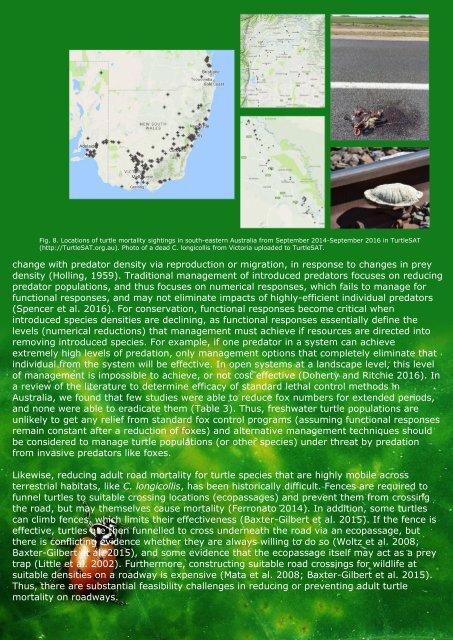Preventing Freshwater Turtle Extinctions
Critically Evaluating Best Management Practices For Preventing Freshwater Turtle Extinctions
Critically Evaluating Best Management Practices For Preventing Freshwater Turtle Extinctions
- No tags were found...
You also want an ePaper? Increase the reach of your titles
YUMPU automatically turns print PDFs into web optimized ePapers that Google loves.
Fig. 8. Locations of turtle mortality sightings in south-eastern Australia from September 2014-September 2016 in <strong>Turtle</strong>SAT<br />
(http://<strong>Turtle</strong>SAT.org.au). Photo of a dead C. longicollis from Victoria uploaded to <strong>Turtle</strong>SAT.<br />
change with predator density via reproduction or migration, in response to changes in prey<br />
density (Holling, 1959). Traditional management of introduced predators focuses on reducing<br />
predator populations, and thus focuses on numerical responses, which fails to manage for<br />
functional responses, and may not eliminate impacts of highly-efficient individual predators<br />
(Spencer et al. 2016). For conservation, functional responses become critical when<br />
introduced species densities are declining, as functional responses essentially define the<br />
levels (numerical reductions) that management must achieve if resources are directed into<br />
removing introduced species. For example, if one predator in a system can achieve<br />
extremely high levels of predation, only management options that completely eliminate that<br />
individual from the system will be effective. In open systems at a landscape level, this level<br />
of management is impossible to achieve, or not cost effective (Doherty and Ritchie 2016). In<br />
a review of the literature to determine efficacy of standard lethal control methods in<br />
Australia, we found that few studies were able to reduce fox numbers for extended periods,<br />
and none were able to eradicate them (Table 3). Thus, freshwater turtle populations are<br />
unlikely to get any relief from standard fox control programs (assuming functional responses<br />
remain constant after a reduction of foxes) and alternative management techniques should<br />
be considered to manage turtle populations (or other species) under threat by predation<br />
from invasive predators like foxes.<br />
Likewise, reducing adult road mortality for turtle species that are highly mobile across<br />
terrestrial habitats, like C. longicollis, has been historically difficult. Fences are required to<br />
funnel turtles to suitable crossing locations (ecopassages) and prevent them from crossing<br />
the road, but may themselves cause mortality (Ferronato 2014). In addition, some turtles<br />
can climb fences, which limits their effectiveness (Baxter-Gilbert et al. 2015). If the fence is<br />
effective, turtles are then funnelled to cross underneath the road via an ecopassage, but<br />
there is conflicting evidence whether they are always willing to do so (Woltz et al. 2008;<br />
Baxter-Gilbert et al. 2015), and some evidence that the ecopassage itself may act as a prey<br />
trap (Little et al. 2002). Furthermore, constructing suitable road crossings for wildlife at<br />
suitable densities on a roadway is expensive (Mata et al. 2008; Baxter-Gilbert et al. 2015).<br />
Thus, there are substantial feasibility challenges in reducing or preventing adult turtle<br />
11<br />
Spencer R-J et al. 2017 Critically Evaluating Best Management Practices for <strong>Preventing</strong> <strong>Freshwater</strong> <strong>Turtle</strong><br />
mortality on roadways.<br />
<strong>Extinctions</strong>. Conservation Biology. In Press.


